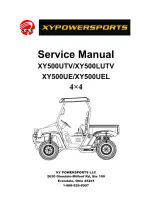
ENGINE LUBRICATION
– Ensure that you follow the procedures
outlined in the engine owner’s manual that is provided as a
supplement to this manual. Failure to follow procedures could
reduce the life of your engine.
VEHICLE LUBRICATION
- Every two or three hours of use
lubricate the following items with several drops of oil; steering
bearing points, brake rod pivot points, pedal pivot points, steering
spindles, and steering rod ends. Use the same grade of
lubricating oil that is used in the engine crankcase.
CHAIN LUBRICATION
- For the best chain life, it should be
lubricated with a graphite type lubricant such as the spray-on type
which evaporates leaving the graphite on the chain. Using oil or
grease on the chain in dusty or sandy riding conditions may cause
dirt particles to stick to the chain resulting in rapid wear from
abrasion.
TORQUE CONVERTER LUBRICATION
- Although the Torque
Converter has been designed for many hours of use, periodic
cleaning and lubrication is necessary for optimum life and
performance. Extremely dust, dry climates would require more
frequent maintenance checks.
Here are the steps to take to maintain the Torque Converter:
Examine the sheaves surfaces of both the front and rear unit.
Clean all dust, dirt and belt residue from surfaces. This must be
done with an evaporative solvent. The belt and belt surfaces must
be free of dirt and grease.
Remove the cover from the front drive unit. Clean all dust and dirt
from internal parts, and re-lubricate with a dry lubricant such as
molybdenum disulfide. Reassemble unit and be sure cover is
securely replaced.
CENTRIFUGAL CLUTCH LUBRICATION
- There are two main
elements that can shorten the life of a clutch - poor lubrication and
dirt/sand.
The clutch contains an oil-impregnated bronze bushing (part '3' on
illustration). It is press fitted inside on the sprocket and surrounds
a steel sleeve onto which a snap ring clips. The small snap ring at
the end of the sprocket holds the clutch together, and for this
reason the snap ring should not be removed.
With the engine off, apply oil (SAE 30 motor oil) to the snap ring
area. (See illustration 2 for details.) To make it easier for the oil
to work its way into the bushing area, try to manually roll the
vehicle along while applying the oil. If you lift the rear end and
support it on the frame you can rotate the rear wheels to work the
oil into the bushing. Never apply grease to this bushing, because
it clogs the pores and retards proper lubrication. For best results,
oil every two hours of running time. (4 or 5 drops).
Dirt and sand are
abrasive and can act
like sandpaper to
prematurely wear the
bushing,
the
sprocket, the chain,
and other parts of
your vehicle. Since
these vehicles are
driven on all kinds of
terrain, it's often hard
to keep the moving parts dirt free. A clean vehicle can prolong the
life of the clutch's bushing and sprocket as well as the chain and
other bearings on the vehicle. Try wiping or brushing away as
much dirt as possible from these areas after each use.
If you find that the drum and sprocket assembly wobbles on the
steel sleeve, this is an indication of a worn bushing. You should
get a new clutch or replacement bushing. A worn bushing can
lead to a thrown chain. Replacing the bushing early when you first
see the excessive wear will prevent the sleeve from becoming
worn and damaged.
FRONT WHEEL REPLACEMENT
- Care must be used when
replacing wheels. DO NOT OVER-TIGHTEN AXLE NUTS. It is
only necessary to tighten the nuts so that the wheel turns freely on
the axle with minimum end play. If the wheel does not turn freely
the nut is too tight.
REAR WHEEL REPLACEMENT
- Loosen the large locknut in the
center of the wheel to remove the rear wheel.
CHAIN ADJUSTMENT
- After the first two hours of operation,
check the chain adjustment and readjust it if it has more than 3/8"
flex. Loosen the engine clamp nuts and slide the engine and jack
shaft assembly rearward to tighten the chain. Allow about 3/8" flex
for proper adjustment. Tighten the nuts securely. On models
equipped with a centrifugal clutch, the engine may need to be
moved forward to tighten the chain.
RECORD THE MODEL NUMBER AND SERIAL NUMBER OF YOUR VEHICLE IN SPACES PROVIDED BELOW
FOR REFERENCE WHEN ORDERING REPLACEMENT PARTS.
Model No. _________________________________________________ Color _______________
Serial No. ________________________________________________________________________________
(red and silver tag attached to go-kart frame)
EngineNo. ________________________________________________________________________________
(from engine)
Illustration 1
Illustration 2
Summary of Contents for Prowler 2787
Page 10: ......




























